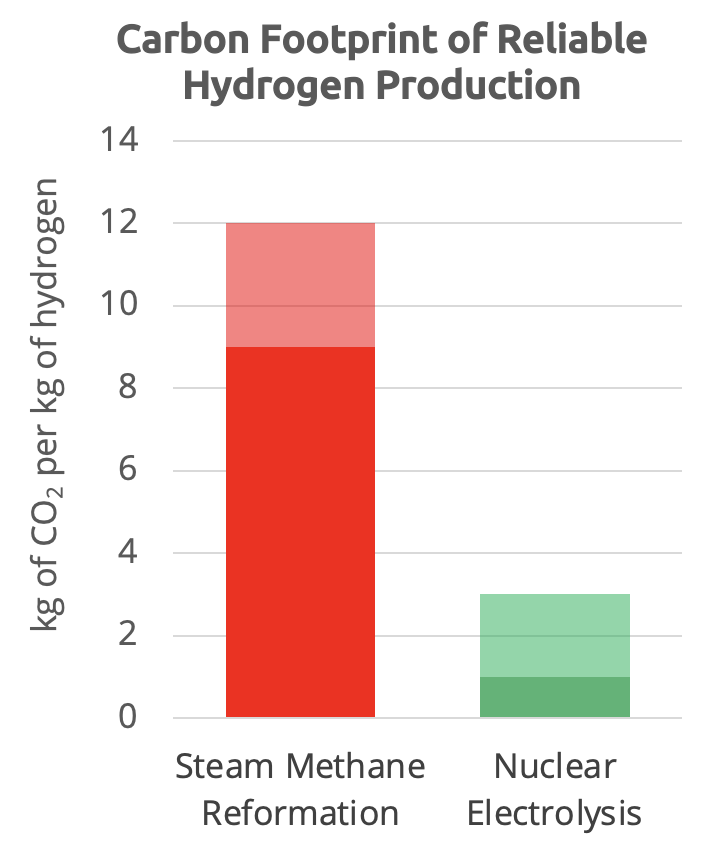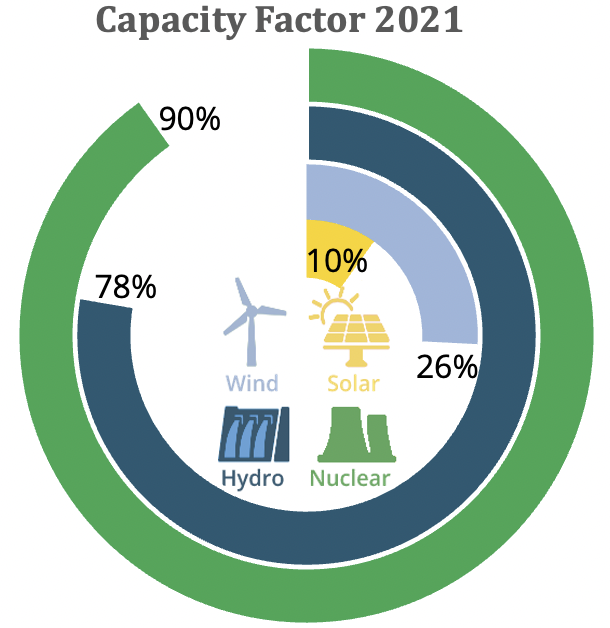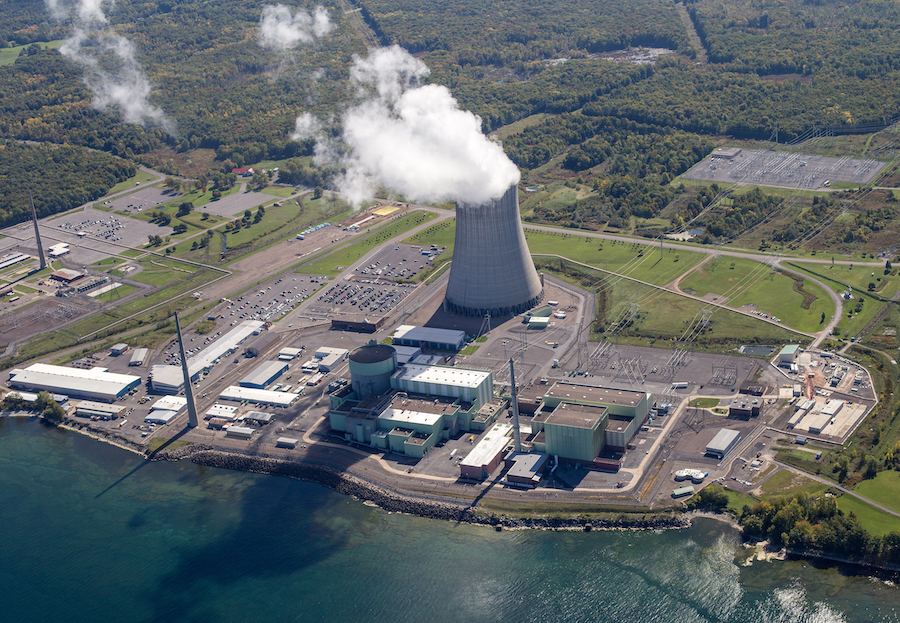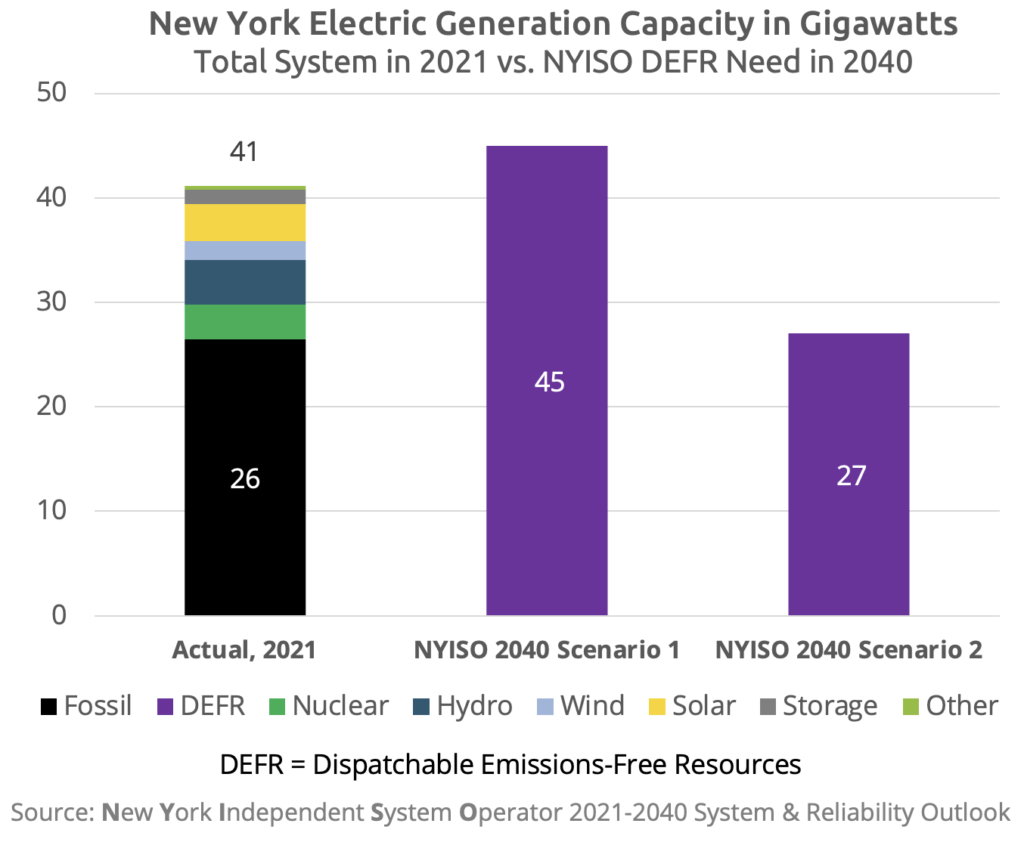New York is leading the U.S. in demonstrating clean hydrogen production to enable affordable and scalable deep decarbonization
Hydrogen
Hydrogen is used in a variety of power- and heat- intensive industries, including petroleum refining, ammonia production, treating metals, and processing foods. Hydrogen can also power fuel cell vehicles, providing transportation with zero tailpipe emissions. In 2019, the U.S. consumed about 10.8 million metric tons of hydrogen. Globally, of the more than 60 million tons of hydrogen annually produced, 53% is used in industrial applications where it serves as a feedstock for the production of ammonia, and 40% is used for refining via hydrocracking, hydrotreating, and sweetening of natural gas. Further, clean hydrogen has the potential to reduce emissions from hard-to-decarbonize sectors such as steel-making and aviation, directly or as a feedstock for zero-carbon fuel.
More than 95% of the U.S. hydrogen production is via steam methane reforming (SMR), a process that consumes fossil gas. While SMR is relatively inexpensive and efficient, the process has a significant carbon footprint (9-12 kg of CO2 per kg of hydrogen produced). Hydrogen can also be produced using electrolysis, which uses electricity to separate hydrogen and oxygen atoms in water. When powered by low-carbon electricity, electrolysis produces clean hydrogen. According to a study by the International Atomic Energy Agency, nuclear energy can produce hydrogen with a carbon footprint of around 1-3 kg CO2 per kg of hydrogen produced.

Hydrogen Electrolysis Requires a Huge Amount of Electricity

High capacity factor: Nuclear power plants produce power around the clock, irrespective of the weather and market forces. This makes them an an ideal source of electricity for hydrogen production through electrolysis as it guarantees maximum utilization over the lifetime of expensive electrolyzers. Reliable and consistent energy supply is crucial for large-scale hydrogen production.
In the future, a large part of the energy needed to produce hydrogen from water may be supplied directly in the form heat from advanced nuclear reactions, avoiding substantial conversion losses.
New York’s Opportunity

The Nine Mile Point Nuclear Generating Station in Oswego, NY became the nation’s first nuclear-powered clean hydrogen production facility in February 2023. The 1 MW demonstration project is supported by the U.S. Department of Energy, with a $5.8 million grant. The 560 kilograms of clean hydrogen produced per day will displace hydrogen feedstock that was trucked in to operate the nuclear plant, owned by Constellation Energy Corporation.
Photo Credit: Businesswire
New York State is in an ideal position to become a national leader in hydrogen technology. Oswego could evolve into a Regional Clean Hydrogen Hub, attracting industries that produce glass, steel, pharmaceuticals, and ammonia for fertilizers. Such a hub could provide clean hydrogen or ammonia as fuel for cargo tankers on the Great Lakes and beyond. These products would outcompete other options on the greenhouse gas footprint. Such industries need a steady supply of hydrogen day and night and every season of the year. This basic economic requirement is perfectly matched with the high reliability of the Nine Mile power plant. It is possible that this Oswego hub could also refuel fuel-cell-powered heavy-duty trucks. These ideas translate into large numbers of good paying jobs and additional tax revenue, a goal of New York’s climate law, Climate Leadership and Community Protection Act (CLCPA).
The hydrogen hub approach has significant advantages of co-locating hydrogen generation with end users. This arrangement does away with the need for an extensive hydrogen distribution and storage network. Not only does this save a great deal of money and time, but also eliminates hydrogen leakage from the surfaces and components of these huge infrastructure undertakings. The hub approach is consistent with the recommendations of the Environmental Defense Council which has recently alerted us to previously unrecognized climate change aspects of hydrogen leakage into the atmosphere. EDF recommends “…it would make more sense to produce [hydrogen] close to where it is used.”
Grid Backup
Further, New York State Energy Research and Development Authority (NYSERDA) granted $12.5 million funding to Nine Mile Point to help demonstrate long-duration energy storage. NYSERDA highlights that economic solutions to grid-scale storage is essential to overcome renewable integration plans. Hydrogen fuel cells can cleanly produce electricity with only water vapor as a byproduct. This demonstration is plant is expected to be operational in 2025.

New York Independent System Operator (NYISO), tasked with keeping the lights on, highlights the need for Dispatchable Emissions-Free Resources (DEFR) to ensure grid reliability under CLCPA, if nuclear power is not expanded. According to NYISO, the needed DEFRs by 2040 exceed the sum of all New York’s generation capacity (Scenario 1, 45 gigawatts) or all fossil generation capacity (Scenario 2, 27 gigawatts).
One major challenge of using hydrogen to generate electricity is that the full-cycle power-to-gas-to-power (P2G2P) efficiency is about 40%. This is like putting an apple in the fridge to eat later, and getting less than half back. This means 2.5x the amount of usable energy needs to be generated, with a commensurate drain on resources, land, and societal wealth.
Other Challenges
Hydrogen’s volumetric energy density is one third that of methane gas, necessitating three times the volume for the same energy content.
A mix of 20% hydrogen and 80% methane gas only reduces the carbon dioxide (CO2) emissions by 6%. Such a hydrogen/methane gas mix would still release 94% of the CO2 of today’s natural gas systems. Even with a 50:50 mix, the CO2 reduction relative to an all methane system is only about 23%.
Molecules of hydrogen, the lightest element, are so small that they have a greater propensity than methane gas to leak from storage and distribution systems. This fact combined with the energy density differential present a multitude of challenges spanning distribution, storage, flow rates, and costs.
- Using the present gas infrastructure as a model for hydrogen development is a poor choice. The present gas infrastructure operates with comparatively low pressures, 200 to 1500 psi, for the piping trans- mission lines. Achieving economically attractive hydrogen energy densities requires very high pressures, in the 10,000 to 15,000 psi range, or extremely low temperatures like minus 253 degrees Celsius.
- The storage capacity of the present natural gas system is huge, about 3 trillion of cubic feet held in depleted gas reservoirs, aquifer reservoirs, underground salt formations, storage tanks, and in the piping system network. This would need to triple to match the performance of the current gas system.
- Because the energy density of hydrogen is about 1/3 that of methane gas, the hydrogen flow rate would have to be three times higher in order to deliver the same amount of energy per unit of time.
- It takes energy to compress hydrogen or to put it into a super cold state. According to the National Research Council and the National Academy of Engineering, “Furthermore, the electric energy needed to compress hydrogen to 5000 psi is 4 to 8 per- cent of its energy content, depending on the starting pressure: to liquefy and store it is of the order of 30 to 40 percent of its energy content.”
Sources
- US Department of Energy. February 2021. Hydrogen Production
- OECD-NEA. November 2012. Nuclear Energy and Renewables: System Effects in Low-carbon Electricity Systems
- Constellation. 2021. Exelon Generation Receives DOE Grant to Support Hydrogen Production Project at Nine Mile Point Nuclear Station
- US Department of Energy. March 2023. Nine Mile Point Begins Clean Hydrogen Production
- US Department of Energy. November 2022. 4 Nuclear Power Plants Gearing Up for Clean Hydrogen Production
- US Department of Energy. What are Regional Clean Hydrogen Hubs
- NYSERDA. September 2022. Governor Hochul Announces $16.6 Million in Awards for Five Long Duration Energy Storage Projects
- Businesswire. September 2022. Constellation Joins State and Federal Officials to Celebrate Progress on Nation’s First Nuclear-Powered Clean Hydrogen Facility
- NYISO. November 2022. Findings From the Outlook: Unprecedented Capacity Investment Needed
- Koestner, POWER Engineers. August 2021. 6 Things to Remember about Hydrogen vs Natural Gas
- Forsberg, The Electricity Journal, October 10, 2021. Addressing the low carbon million-gigawatt energy storage challenge
- National Research Council and National Academy of Engineering. 2004. The Hydrogen Economy, Opportunities, Costs, Barriers, and R&D Needs
- Brandon & Kurban. June 2017. Clean energy and the hydrogen economy